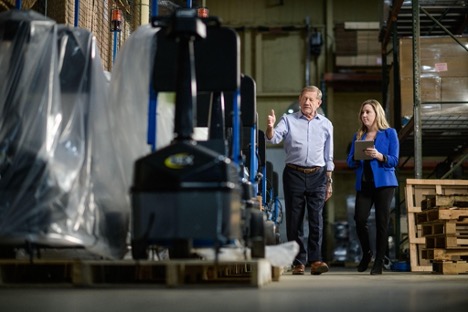This website uses cookies so that we can provide you with the best user experience possible. Cookie information is stored in your browser and performs functions such as recognising you when you return to our website and helping our team to understand which sections of the website you find most interesting and useful.
Amigo Saves 10% Plus 10 Hours/Week on LTL Shipping by Integrating ShipEngine & NetSuite
Amigo Mobility launched in 1968 when a plumbing and heating contractor built the first Amigo for a family member with multiple sclerosis — pioneering the future of personal mobility. More than 5 decades later, Amigo Mobility has grown into one of the leading manufacturers of personal mobility devices, including motorized shopping carts, material handling carts, personal mobility aids and aircraft tugs. Selling to big box retailers, distribution centers, and direct to consumers, the shipping of Amigo’s various products has become much more complex since 1968.
Because personal mobility devices are larger and heavier than the average retail product, they ship through less-than-truckload (or LTL) carriers. During a goal-setting exercise in 2021’s third quarter, a member of Amigo’s shipping department described just how onerous shopping for LTL rates and scheduling LTL pickups had become.
Amigo saw an opportunity to spend less time on shipping and to potentially save on LTL shipping rates — if only it could find a way to automate and streamline the fulfillment process.
The Challenge: Standardizing Integrations to 10-Plus LTL Carriers
Ryan Maher, Director of Administration at Amigo, started searching for a solution to Amigo’s time-intensive, heavily manual approach to LTL shipping. He first looked at electronic data interchange (EDI), but he realized the company’s fulfillment needs were too complex for EDI to be effective. They also needed more “real-time” connectivity with their carriers.
He then explored building his own API integrations to each of the 11 carriers Amigo was using. Unfortunately, all of the carriers used slightly different approaches to their APIs, which made building and maintaining 11 different integrations incredibly difficult.
“Some of the carriers were using SOAP APIs and XML,” said Maher. “Other APIs were REST and used JSON. I finally realized I was going to have to build 11 different integrations with 11 different parameters and then manage account numbers and refresh tokens for all of the carriers. I also knew we’d be adding more carriers in the future.”
Needless to say, building and managing 11 different integrations would require more time and effort than the manual shipping process that Amigo was trying to improve. In August 2021, Maher discovered ShipEngine’s recently launched LTL integrations on LinkedIn.
“I looked at ShipEngine and realized this is a platform that will standardize all these carriers, so I only have to build my side once,” Maher said. “I wasn’t sure: Should I build these out on my own? Then I started thinking about the maintenance and adding more carriers as needed, and it just became a no brainer for me. I said, ‘Let’s try this platform out,’ and I’m so happy I did.”
Amigo’s ShipEngine Integration Delivers Time and Cost Savings
Maher started building the integration between NetSuite (Amigo’s ERP) and ShipEngine that would connect Amigo to all of its needed LTL carriers — 11 in total. He relied on the documentation and guidelines to get started, and he contacted ShipEngine’s support team as needed for guidance on the integration.
As one of ShipEngine’s earliest LTL integrators, Maher was also able to provide real-time feedback on the ease of integration and ideas on how to improve the user experience. By December, Amigo was ready to launch its new shipping process that ran rate quotes and pick-up scheduling through ShipEngine. By early 2022, the benefits were obvious.
“Our team had been spending 2 hours a day going online to get rate quotes and scheduling pickups,” Maher said. “Now we can quote all the carriers at once and compare them. When we’re ready to schedule the day’s pickups, we click a button and schedule all of them in seconds. We’re also using the document features and getting PODs and signed BOLs for our customers that require them. Overall, we’re saving at least 10 hours a week. That’s more than a quarter of a person. That’s huge for us.”
Maher also estimates that Amigo is saving more than 10% on its LTL shipping costs. Beyond the raw savings, Amigo is now able to provide the most accurate shipping quotes to its customers.
“Before, to get an accurate rate, we had to quote each order with each carrier one by one,” said Maher. “With our growth, we just didn’t have time to do this for every single order. Often, we were estimating and losing on freight. We now know we are getting the best rate, and more importantly I’m able to get our customers the best rate.”
Somewhere between 5% and 10% of Amigo’s business is direct-to-consumer, but it mostly sells to retailers and distribution centers through its retail and material handling product lines. Due to Amigo’s diverse customer base, the company has to conform to several unique LTL shipping guidelines.
In early 2022, one of Amigo’s largest customers changed its LTL carrier of choice with less than 24 hours notice. When the customer announced the change through an email, Amigo had no relationship with the new LTL carrier. The carrier was available through ShipEngine, however, which made the prospect of establishing an account and getting LTL shipments up and running through the new carrier far easier.
Now that Amigo’s ShipEngine integration is complete, the 10% cost reduction and 10 hours saved each week free up resources to allocate elsewhere. The ShipEngine integration also makes ongoing maintenance and troubleshooting easier to manage.
“If there’s a problem, I don’t have to look in 11 different places,” said Maher. “It’s all in one spot because I’m sending standardized information to ShipEngine every time. They handle the nuances and carrier API requirements for me.”
Bringing LTL-Style Efficiency to Amigo’s Parcel Shipping
Amigo has streamlined its LTL shipping, and now the company wants to bring the same level of efficiency to its parcel shipping through ShipEngine. Amigo sends anywhere from 3,000 to 5,000 parcels each month. It uses time-consuming and cost-intensive manual processes similar to the way it once handled LTL shipping.
“We don’t always know the best service to use with each parcel that leaves our facility,” Maher said. “We literally have sticky notes that say things like, ‘If this package is going to Louisiana, use FedEx Ground.’ That’s probably right most of the time, but there has to be a better way.”
Amigo’s experience with implementing ShipEngine for LTL shipping makes the platform an obvious choice for parcel shipping, too.
“The ease of integration and scalability is significant with ShipEngine,” said Maher. “I started with one LTL carrier, and then the next one was a little easier, and the next after that was even easier. It just kind of builds on itself. You’re able to just keep adding information in, and it really doesn’t matter how many carriers you add or what you need to do once you set it up, it’s really built to scale.”
Are you interested in bringing the same efficiency and cost savings to your operations, whether for LTL or parcel shipping? Get in touch with us to speak to a shipping expert about your business and its unique needs.






